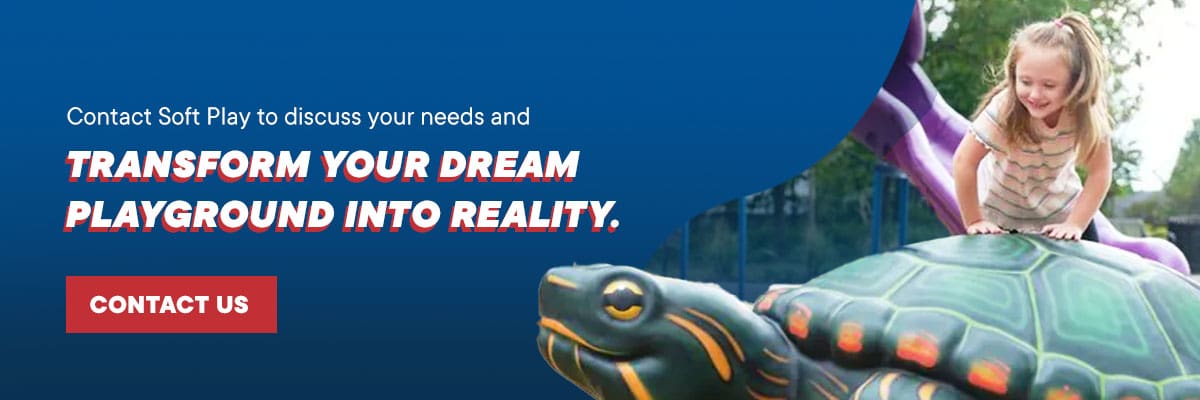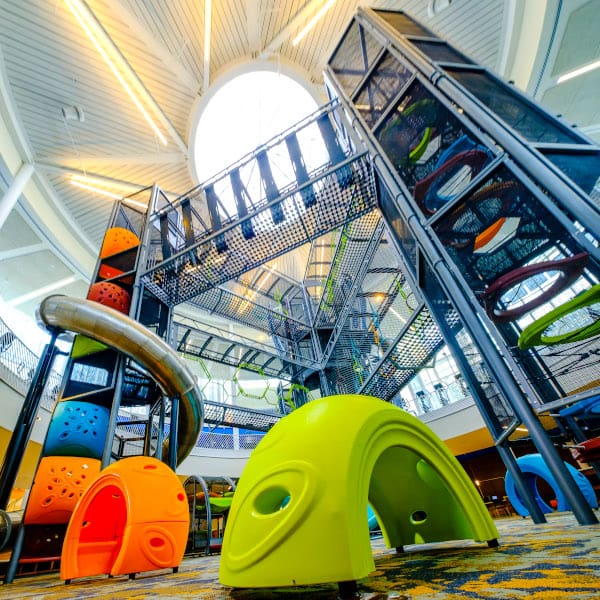A Guide to Playground Flooring and Surfacing
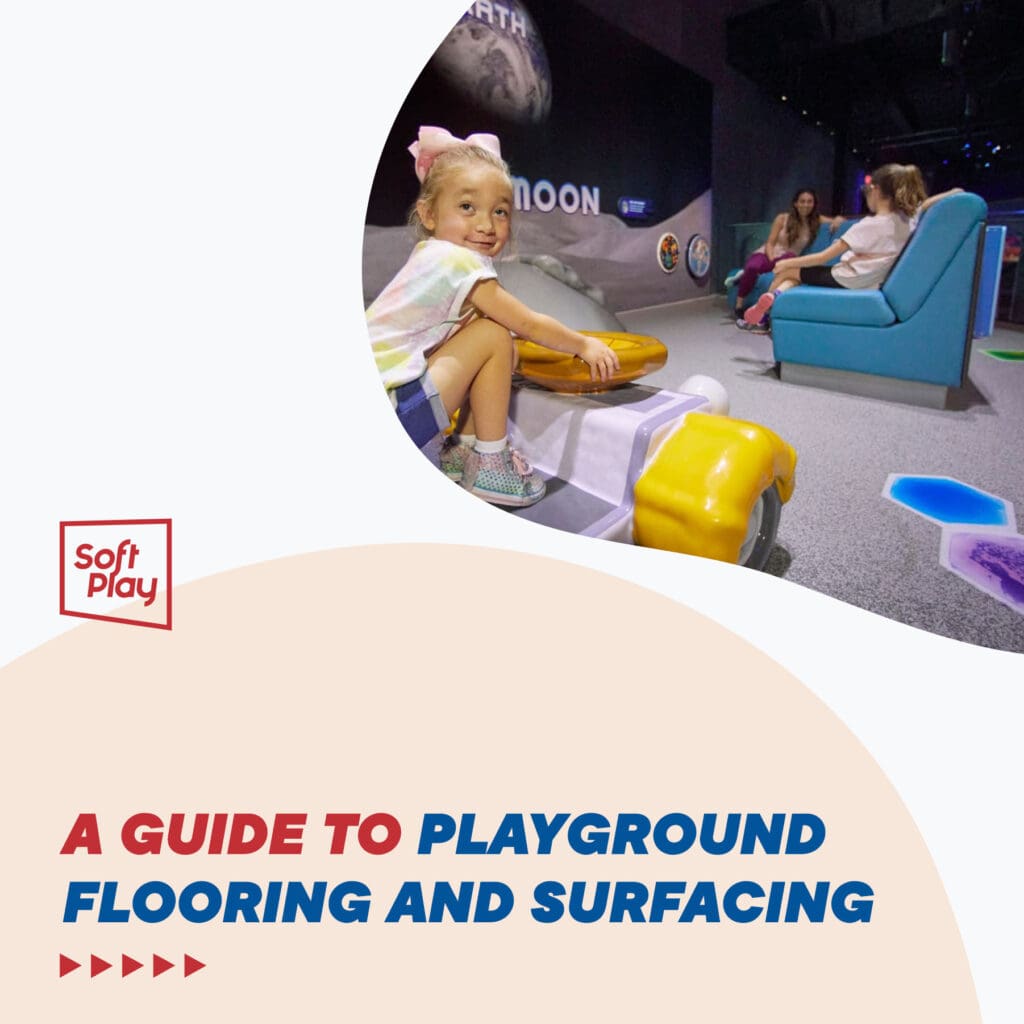
A Guide to Playground Flooring and Surfacing
The ground may not be the first element that comes to mind when thinking about playground design, but it should be! Surfacing and flooring are the foundation of any recreational area. Kids run, jump and sometimes fall on the playground, so durability and shock absorption are vital.
Various playground surfacing and flooring options exist for schools, entertainment centers or restaurants. But which is right for you? This guide explores the different types of playground flooring and surface options, their benefits and tips for choosing the right one.
Why Does Playground Surfacing and Flooring Choice Matter?
Soft playground materials cushion falls and help prevent severe accidents. Every year, over 200,000 kids visit the emergency room with playground-related injuries. With the right surfacing or flooring, you can help kids spend less time in the hospital and more time playing.
Accessible playground surfacing lets kids of all abilities interact. Under the Americans with Disabilities Act (ADA), all new commercial play areas must comply with ADA guidelines.
Playground Surfacing and Flooring Safety Standards
Safety is a top concern in kid’s playgrounds. Various bodies enforce strict standards for everything from equipment to the ground. Below is a summary of playground surfacing and flooring regulations.
U.S. Consumer Product Safety Commission (CPSC)
The CPSC issues mandatory standards to reduce injury risks associated with unsafe products. Under the CPSC, at least 12 inches of shock-absorbing playground surfacing or flooring must surround equipment. Approved materials include mulch, sand, wood chips, pea gravel or rubber.
International Play Equipment Manufacturers Association (IPEMA)
IPEMA is a nonprofit trade association representing manufacturers of playground equipment. The organization provides third-party certification of equipment and surfacing. Guidelines include:
- Preferred playground surfacing and flooring: IPEMA-recommended materials include (PIP) rubber, safety-tested rubber mats, engineered wood fiber, rubber mulch or artificial turf. These options keep kids safe while they play. Avoid asphalt, dirt, concrete or grass — they lack the cushioning and safety kids need.
- Loose-fill requirements: If you opt for loose-fill materials, ensure a depth of at least 8 to 12 inches. This depth softens falls, particularly in high-traffic areas like under slides and swings.
- Coverage: The flooring or surfacing should extend from under the play equipment at least six feet away in every direction. It should stretch back and forth to twice the height of the swing’s suspending bar.
ASTM International
ASTM International sets global standards for materials across different industries. In addition to general ASTM standards, each surface or flooring type must meet specific requirements. For example, ASTM 2075 applies to engineered wood fiber (EWF) only.
Playground Surfacing and Flooring Options
Playground surfacing and flooring materials are either unitary (smooth and continuous) or loose-fill. Unitary materials include pour-in-place (PIP) rubber, synthetic turf and rubber tiles. Loose-fill surfaces consist of small, individual pieces. Examples of these materials include wood chips, sand, pea gravel, shredded rubber and EWF.
The choice between unitary and loose-fill options depends on your needs. Loose-fill materials suit outdoor playground surfacing, while solid options work well as indoor playground flooring. Here’s a closer look at each type of material and its benefits.
1. Wood Chips
Wood chips or mulch are a type of loose-fill material often used in landscaping. The Consumer Product Safety Commission (CPSC) recommends using wood chips without chromate copper arsenate treatment. Playground surfacing should have at least 12 inches of wood chips to address compressing and displacement.
- Pros: Wood chips and mulch are easy to find and install and are generally low-cost.
- Cons: Loose materials tend to scatter, which can cause mess and safety risks. While it meets basic ADA requirements, wood chips lack the firmness needed for accessibility.
2. Sand
Like wood chips, sand is another easy-to-install, low-cost surfacing option. Avoid using sand on a playground with high fall areas. Fall height refers to the distance between the highest point of a designated play surface and the ground underneath.
- Pros: Sand is cost-effective, eco-friendly, and easy to maintain. It can add a sensory element to play.
- Cons: Like wood chips and many other loose-fill materials, sand is not ADA-compliant. Sand may also conceal hazardous objects.
3. Pea Gravel
Pea gravel consists of small, round pebbles. While inexpensive, it’s best to avoid this loose-fill option. The fall height for pea gravel is less than 5 feet. It also fails to comply with the ADA and poses a safety hazard. Kids might throw the pebbles at others or put them in their mouths. Pea gravel also requires more maintenance.
4. Shredded Rubber
Shredded or crumb rubber is a type of loose-fill mulch often made from recycled tires. Consider the following pros and cons:
- Pros: This low-cost material meets the minimum requirements for ADA approval and is easy to install.
- Cons: Like all loose-fill material, you must check and maintain the proper depth.
5. Engineered Wood Fiber
EWF is a loose-fill material made from wood ground into fiber. Check out the upside and downside of EWF:
- Pros: EWF complies with ADA regulations and doesn’t attract insects like other natural materials. The surface absorbs water well and is easy to install.
- Cons: As with other loose materials, you must pay attention to the depth of EWF, as pieces can become displaced. Over time, it often becomes compressed.
6. Synthetic Turf
Synthetic turf consists of rubber and artificial grass blades. You might see synthetic turf used in athletic fields, but it also works as a playground surfacing or flooring material.
- Pros: With proper installation and padding, synthetic turf meets ASTM standards. Depending on its thickness, it provides a high level of fall protection. Unlike wood chips or pea gravel, artificial turf does not get dislodged.
- Cons: This surfacing or flooring may need extra padding to increase the fall height. The turf, ground preparation and irrigation make this a more costly option.
7. Pour-In-Place Rubber
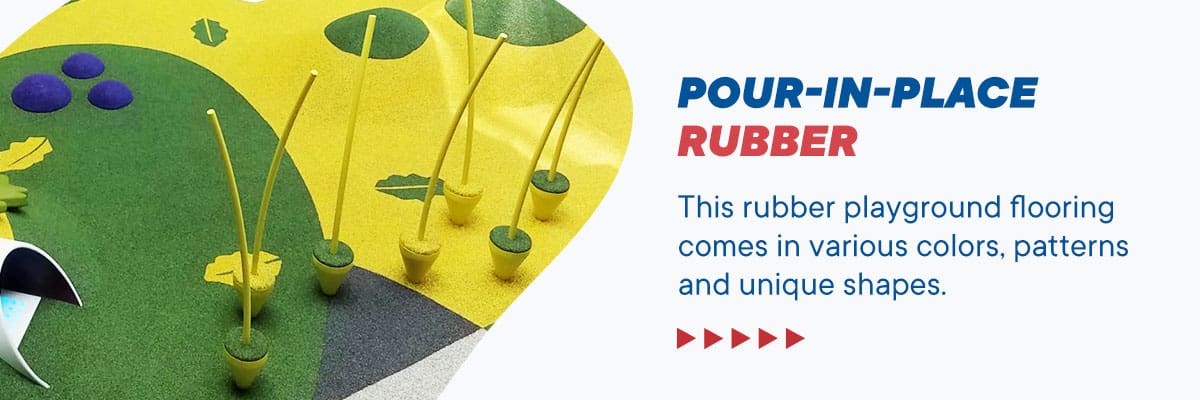
Pour-in-place rubber is a unitary surface that works for both outdoor and indoor play areas. Suppliers mix PIP on-site and place it wherever you need a fall-attenuating surface. The rubber comes in various colors, patterns and unique shapes. You can tailor the surface with PIP rubber to suit your playground design or business theme.
- Pros: This permanent solution is durable and low-maintenance. It offers exceptional shock absorption combined with visual appeal. Plus, it complies with ADA standards, making it one of the best soft play surfacing or flooring available for kids.
- Cons: This material can be more expensive than loose-fill surfaces. Its longevity, durability, and easy maintenance offset the initial cost.
8. Modular Tiles
Like PIP, modular rubber tiles are a synthetic, unitary surfacing material suitable for outdoor areas or indoor rubber playground flooring. These 2-by-2-foot square tiles attach with durable subsurface clips. Modular tiles are a cost-effective, attractive and compliant playground surface option.
- Pros: These ADA-approved tiles are easy to install, maintain and repair. They come in a variety of colors to match your playground vision.
- Cons: Expect to pay more upfront than cheaper options like sand or wood chips. The quality and benefits of modular tiles add value compared to low-budget options.
9. Carpet
If you want plush, padded indoor playground flooring that is gentle on little feet, carpet is a perfect choice. It comes in a rainbow of colors and designs, so you can get creative!
Opt for carpet formulated specifically for playgrounds. For example, kid-friendly DuraSoft Safety Flooring from Soft Play® is a liquid-proof carpet with a 1.5-inch pad thickness.
- Pros: The thick DuraSoft Safety Flooring surface stops spills from getting through, making it easy to clean. It meets ASTM F1292’s 4-foot fall height. Combined with ADA-compliant entrance ramps, Durasoft complies with ASTM F1951 ADA accessibility requirements.
- Cons: Carpet can be more expensive than other materials. You must invest in a product made for playground flooring, as normal carpeting fails to meet safety and ADA standards.
How Do You Choose the Right Surface or Flooring for a Play Area?
Every playground has unique requirements for safety, accessibility, maintenance and appearance. ADA-approved loose-fill material might work at a school but not in a restaurant play area. No one wants wood chips with their Caesar salad! To guide you in the right direction, here are surfacing and flooring ideas for various settings:
Schools
Project managers must consider many factors when selecting outdoor playground surfacing for schools. First, they must choose a material that’s both ADA-compliant and impact-attenuating. Schools can combine accessible and non-accessible surfacing but must follow specific guidelines.
According to the ADA, at least one of each type of ground-level play component must be on an accessible route. At least 50% of the elevated play components must be on an accessible path. To meet these requirements, schools should choose PIP, rubber tiles, synthetic turf or EWF for accessible areas.
Schools must also consider maintenance requirements when choosing a surface. A responsible party must check the depth and replenish materials when needed. PIP and rubber tiles are excellent low-maintenance options.
The average school has hundreds of students, so playgrounds must handle high traffic. A durable material like PIP or modular tiles can withstand frequent use.
Daycare Centers
Most daycare centers accommodate toddlers and preschool-age kids. Some facilities welcome infants, while others provide after-school care for older kids. Choose surfacing or flooring that caters to the age range of your daycare center.
If you care for infants or toddlers, avoid using loose-fill pea gravel or wood mulch. These materials may present a choking hazard. In this case, unitary surfacing or flooring works better.
Think about how you want parents to perceive your facility. Safety is a top concern when parents choose a daycare. Show them you care about their little ones by selecting soft, high-quality surfacing or flooring like PIP, carpet or rubber tiles. These options create a bright, stimulating environment that promotes growth and development.
Family Entertainment Centers
An entertainment center must appeal to families and stand out from competitors. Set yourself apart with bright, fun colors, innovative play equipment and high-quality materials. You could also select materials that match a particular theme or color scheme. The indoor play area flooring must handle impact from falling equipment. Opt for a material that’s easy to maintain and access.
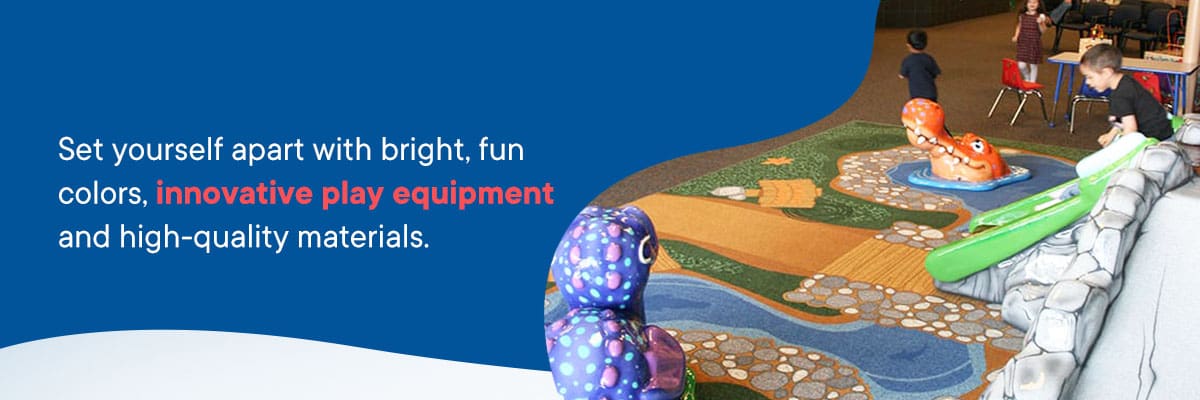
Go with carpet, PIP or rubber tiles to attract families to your business. Design creative, exciting patterns on the ground while meeting safety and accessibility requirements. Plus, they require little upkeep, which means less downtime and more feet through the door. A quality, durable material like PIP or DuraSoft carpet needs fewer repairs, saving you costs in the long run.
Gyms
These days, parents recognize the importance of physical activity for the entire family. Gyms give kids a place to burn off all their energy. If you own a health and fitness center and want to install an indoor recreational area, you need the right flooring to protect kids as they play and give their parents peace of mind.
Go for unitary flooring like PIP, rubber tiles or DuraSoft carpet. These materials work best for indoor play areas, and you can select a color that matches your brand. They are also easy to clean, which makes them ideal for keeping your gym in tip-top shape.
Restaurants
When installing a restaurant play area, choose a solid surface over a loose one. Loose fill can end up in the kitchen or dining area. Select easy-to-clean flooring that shows dropped utensils, food, pests or other items. A smooth material like PIP looks cleaner, which is something restaurant customers desire.
PIP rubber also allows you to create an exciting theme. Some kids get bored at restaurants, but an engaging play area adds excitement. When they remember how much fun they had, they may ask their parents to choose your establishment over a competitor.
Retail Centers
Indoor or outdoor play areas can make the shopping experience more pleasant for parents and kids. Opt for a quality, easy-to-maintain surfacing or flooring material that can handle heavy traffic and appeal to all ages.
Like other businesses with indoor play areas, your best options are PIP, modular tiles or safety carpet flooring. A shopping center must accommodate a range of ages and abilities.
How Do You Budget for Playground Surfacing or Flooring?
Surfacing or flooring is a worthwhile part of your playground budget. Your spending limits depend on the material and the amount of space you need to cover.
Loose-fill has the lowest upfront cost for tight budgets. EWF is a budget-friendly, ADA-approved loose-fill material. You can also combine loose materials with accessible pathways made of PIP rubber.
PIP or modular tiles are worth the cost for quality, accessibility and durability. A rubber surface or flooring material can still be affordable. Here’s what to consider.
Installation
Quick, easy-to-install materials can save on installation fees. DIY enthusiasts can place modular tiles without hiring professionals. PIP needs professional installation, but you can save by preparing the site before the pros arrive.
Durability
Playground flooring or surfacing longevity can affect your budget over time. PIP or carpeting can last for years, while materials like wood mulch need annual replenishing.
Maintenance
Some materials require more attention to maintain the right level of impact cushioning and accessibility. For example, EWF needs regular inspections for depth and to uncover any hidden hazards. PIP, on the other hand, requires very little maintenance. Rubber flooring installed in indoor play areas away from the elements lowers maintenance costs.
Visual Appeal
As a business owner, you likely want to attract more customers. One way to do this is to create a play area that leaves a great impression and makes families want to return. Attractive surfacing or flooring can add to the play experience. With PIP, you can create a custom design that makes your play area stand out. As a result, you enjoy a greater return on your investment.
Factors to Consider When Choosing Surfacing or Flooring for Your Business
Shopping for the right surfacing or flooring type is easier if you consider the following factors:
Accessibility
Is the material accessible, and does it allow kids with mobility devices to use the play area? You must combine non-accessible substances like sand or wood chips with accessible materials. Here is a summary of ADA playground surfacing and flooring requirements:
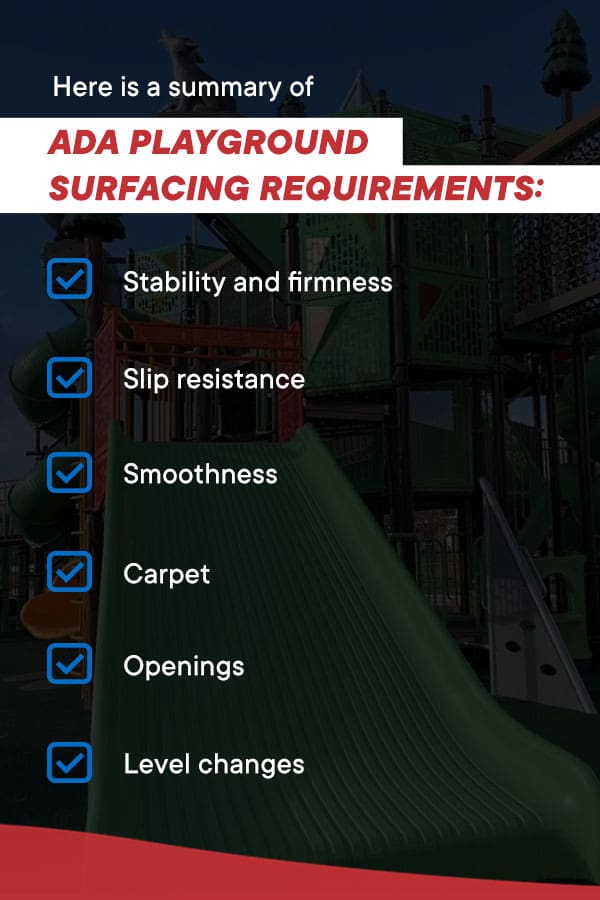
- Stability and firmness: A stable ground material withstands movement, while firm options hold their shape under pressure. Accessible surfacing or flooring should stay reliable regardless of what’s on or happening around it.
- Slip resistance: Surfacing and flooring must prevent slipping and accommodate crutches or other mobility aids. Choose materials, finishes or textures that help prevent slips and falls. Maintenance is key to keeping things compliant.
- Smoothness: Wheeled mobility aids find navigating uneven ground, like cobblestones, challenging. So smooth surfaces are the way to go!
- Carpet: Thick, fluffy carpet may be kind to feet but can cause problems for wheelchair users. ADA standards specify pile height, texture, and backing. Carpet edges must fasten to the ground to stop curling.
- Openings: Any gaps or openings must be narrowed to stop wheelchair casters from getting stuck.
- Level changes: Changes in level over ½ inches count as a ramp or curb ramp.
You can ensure ADA compliance by installing a material like PIP or rubber tiles throughout your play area.
Size Requirements
The size of the area can affect your budget and surfacing material choice. Allow at least 75 square feet per kid in the main play zone. If you predict a bustling playground filled with kids, you need much more surfacing! A larger space has more budget considerations, while a smaller area lets you splurge on higher-quality materials. Plus, a pro can help you think outside the box! Combine different surfacing types to maximize space and budget.
Budget
Your budget might be the factor determining the type of surfacing or flooring you choose. As mentioned above, loose-fill materials cost less upfront than unitary options. Solid surfaces pay for themselves with lower maintenance needs, longer life span and compliance. The cost of surfacing or flooring is about more than the materials — it’s about upkeep expenses. Include maintenance, repair and replacement costs in your budget.
Cost and quality go hand in hand. Materials like pea gravel, sand, or EWF may be cheaper than solid rubber but present more of a safety hazard. These choices may not meet ADA or ASTM standards.
Customization Options
Do you envision a playground with a unique style that captures the imagination? If so, consider customizable options like PIP rubber, modular tiles or DuraSoft. These allow you to unleash your artistic side. Create an inspiring play area that leaves a lasting impression on kids and parents alike. Think bright colors and fun patterns that enhance the play experience!
Trends
Staying updated with current playground trends keeps your space fresh and exciting. In recent years, vibrant unitary surfaces and flooring with interesting patterns have become a hit. Some playgrounds even incorporate designs into play, making the ground as much a part of the fun as the equipment itself!
Goals
Ask yourself what you hope to accomplish with your playground. Are you aiming for inclusivity, brand awareness or a specific aesthetic? Do you want to attract more families to your establishment? Your goals will help guide your decision and ensure the final playground meets objectives.
Common Playground Surfacing Questions
You asked, and we answered! These answers to flooring- and surfacing-related questions can help you make the right choice.
Are Rubber Playgrounds Toxic?
While some recycled tire rubber may contain chemicals, reputable providers prioritize nontoxic materials. When investing in rubber surfacing or flooring, ensure you partner with a trusted supplier.
Is Rubber Mulch Good for Playgrounds?
Rubber mulch or shredded rubber is an eco-conscious recycled material that withstands wear. It has a high impact rating, and you need less of it to cover an area than other loose-fill materials. However, rubber crumbs may have chemicals. It also takes more maintenance than PIP or modular tiles.
Which Is the Best Material for Playground Surfacing and Flooring?
The ideal material depends on your budget, accessibility, environment and age range. At Soft Play, we recommend PIP rubber, carpeting or modular tiles. These options offer excellent durability, impact absorption and versatility. They are also ADA-compliant. With different colors, you can create an active play wonderland.
The Benefits of Choosing Soft Play Safety Surfacing and Flooring
Deciding on a type of surfacing or flooring material is a big decision. A play area is an investment in your business that affects your customers’ experience. Are you ready to explore your options? Contact Soft Play to discuss your needs and transform your dream playground into reality.
At Soft Play, we offer smooth, durable and accessible playground surfacing and flooring to handle hours of high-impact play. When you work with us, you enjoy other benefits such as:
- Free design consultation: Our designers collaborate with you to create unique, durable, custom-made surfacing or flooring. We bring your vision to life with colors or patterns to make your play area pop and stick in your customers’ minds.
- Expert advice: We use our expertise to help grow your business, attract new customers and keep them returning. Play Soft has over 30 years of experience in clever playground design.
- Quality and value: We prioritize quality with all our American-made play equipment, flooring and surfacing materials. You can be sure our products offer excellent value.
- Exceptional service and support: Our customer service is out of this world! Our team is on standby to answer your questions and make recommendations.
Every playground needs soft, quality surfacing or flooring. To learn more about our playground options at Soft Play, request a quote today!
